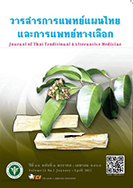The Effectiveness of Thai Hermit Exercise among Female Students with Primary Menstrual Pain
Main Article Content
Abstract
Primary menstrual pain is a critical problem for female students as this problem can affect their
study and their daily life. The Thai hermit exercise (Ruesie Dutton) might be an alternative choice for
relieving such menstrual pain without the use of painkiller drugs. This study aimed to evaluate the effect
of Thai hermit exercise on the degree of menstrual pain among female students. Sample group included
30 of the first- and second-year female students from Dusit Commercial Vocational College Nonthaburi
as a group without exercise (control group) and 30 of those from Kanchanabhisek Institute of Medical
and Public Health Technology as a group with Thai hermit exercise (experimental group) for 45
minutes/session, 3 sessions/week, totaling 8 weeks. Both control and experimental groups were evaluated
for perceived menstrual pain and co-menstrual symptoms. All data were analyzed to determine
frequency, percentages, means and standard deviation. Paired sample t-test and independent t-test were
used for statistical tests. The study found that after Thai hermit exercise, the experimental group had a
significantly lower level of perceived menstrual pain and its co-symptoms (p < 0.05); and their pain
reduction was significantly greater than that for the control group (p < 0.05). However, this study
ambiguously confirms that the Thai hermit exercise can reduce perceived menstrual pain and its associated
symptoms. This is because of study limitations such as the inappropriate research design, the lack
of sampling bias control, unequal treatment for the control and experimental groups, and the measurement
of dependent variables by the researcher.
Article Details
References
www.uptodate.com/contents/ primary-dysmenorrheain-adult-women-clinical-features-and-diagnosis.
2 . LIONG Chi-ki J. The Association of primary dysmenorrhea with the perception of pain, work stress and lifestyles of nurses (Dissertation). Hong Kong: The
University of Hong Kong; 2006.
3. Chongpensuklert Y, Kaewrudee S, Soontrapa S, Sakondhavut C. Dysmenorrhea in Thai secondary school students in Khon Kaen, Thailand. Thai J Obstet Gynaecol. 2008;16(1):47-53.
4. Burnett MA, Antao V, Black A, Feldman K, Grenville A, Lea R, et al. Prevalence of primary dysmenorrhea in Canada. J Obstet Gynaecol Can. 2005;27(8):765-70.
5. Ortiz MI. Primary dysmenorrhea among Mexican university students: prevalence, impact and treatment. Eur J Obstet Gynecol Reprod Biol. 2010;152(1):73-7.
6. Eryilmaz G, Ozdemir F, Pasinlioqlu T. Dysmenorrhea prevalence among adolescents in Eastern Turkey: Its effects on school performance and relationships with
family and. J Pediatr Adolesc Gynecol. 2010;23(5):267-72.
7. Wong LP, Khoo EM. Dysmenorrhea in a multiethnic population of adolescent Asian girls. Int J Gynaecol Obstet. 2010;108(2):139-42.
8. Bangkok Health Research Center. Knowledge about dysmenorrhea [Internet]. 2014 [cited 2015 Feb 2]. Available from: http://www.manager.co.th/QOL/ViewNews.aspx?NewsID=9570000140319. (In Thai).
9. Parai W, Aranyabhaga P. Prevalence of primary dysmenorrhea, self-management behavior and factors associated with primary dysmenorrhea among undergraduate student, Siam University, Thailand. APHEIT Journal. 2012;10(1):16-29. (In Thai).
10. Youngwanichsetha S. Premenstrual syndrome, dysmenorrhea, and the practice of relieving pain among female students in The Prince of Songkla University,Thailand. Songklanagarind Medical Journal. 2005;23(4):209-17. (In Thai).
11. Tangchai K, Titapant V, Boriboonhirunsarn D. Dysmenorrhea in Thai adolescents: Prevalence, impact and knowledge of treatment. J Med Assoc Thai. 2004;87(3):69-73.
12. Thai Health Promotion Foundation. Dysmenorrhea not a small problem for women [Internet]. 2014 [cited 2015 Aug 4]. Available from: http://www.thaihealth.or.th/
Content/25816-ปวดประจำเดือน%20ปัญหาไม่เล็กสำหรับผู้หญิง.html (in Thai).
13. Subcharoen P, Deewises K, Viwatpanich K, Chaianek M, Sitikaipong K. Diseases of menstruation according to the theory of Thai traditional medicine. Nonthaburi:
The War Veterans Organization of Thailand Under Royal Patronage of His Majesty the King; 2003. (In Thai).
14. Pukhamsuk T. The Therapeutic evaluation of dysmenorrhea and irregular menstruation by using Thai herbal medicine recipes (PRASAPLAI) (thesis). Chiang
Rai: Chiang Rai Rajabhat University; 2012. (In Thai).
15. Subcharoen P. Thai hermit exercise. Nonthaburi: The War Veterans Organization of Thailand Under Royal Patronage of His Majesty the King; 1994. (In Thai).
16. Porkar M. Effects of yaga on premenstrual syndrome (thesis). Chiang Rai: Mae Fah Luang University, 2015. (In Thai),
17. Yang NY and Kim SD. Effects of Yaga program on mentrual cramps and mentrual distress : A single - blind, randomized controlled trial [Internet], 2016 [cited 2015 Nov 6]. Available from: https://www.ncbi.nlm.nih. gov/m/pubmed/27315239/.
18. Faculty of Medicine Siriraj Hospital. Pain scale. Bangkok: Mahidol University; 2006.
19. Pongnaratorn P. The effects of applied Ruesi Datton exercise on movement and flexibility of the back in low back pain patients. Journal of Thai Traditional & Alternative Medicine. 2015;13(3):247-57. (In Thai).
20. Burapha P. Thai hermit exercise in Wat Pho. Bangkok: Hitech printing; 2013. (In Thai).
21. Sreethanee T. The effect of exercise program on dysmenorrhea among female students at Khongkapracharak School (thesis). Chiang Mai: Chiang Mai University; 2003. (In Thai).
22. Ounnapiruk L, Ronnarithivichai C, Thongcharoen V, Leelahakul V, Khumtaveeporn P. Pathology of Nursing. Bangkok: Boonsiri Printing; 2009. (In Thai).
23. Department for Development of Thai traditional and Alternative Medicine. Thai hermit exercise. Nonthaburi:Smart Creation Intermedia; 2003. (In Thai).
24. Department of Mental Health. Emotion vs Food [Internet]. 2006 [cited 2015 Nov 25]. Available from: http://www.dmh.go.th/news/view.asp?id=1020. (In Thai).


